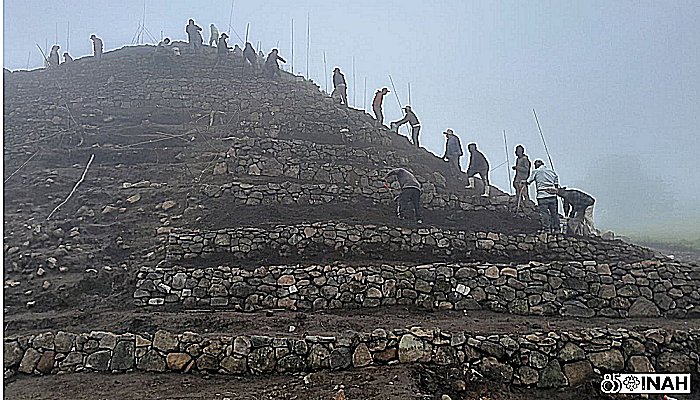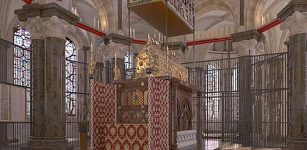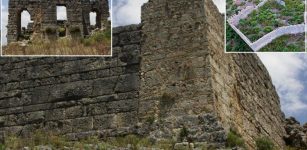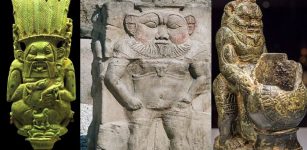INAH Archaeologists Focus On Ancient Religious And Ceremonial Site Of Teteles Of Avila Castle, Puebla, Mexico
Conny Waters - AncientPages.com - Archaeological excavations conducted at Tetelihtic in Mexico's State of Puebla have uncovered the site's historical significance as a major ceremonial complex. The findings highlight the site’s role in ancient times, especially, due to its astronomical alignments, which suggest it was an important center for ceremonial activities.
Image credit: INAH
Located in the municipality of Teteles de Ávila Castillo, Tetelihtic was first reported in 1939 by Vicente Lombardo Toledano but a systematic excavation started in 2014, led by the National Institute of Anthropology and History (INAH), in collaboration with local government and organizations.
The works were conducted with the backing of 25 dedicated workers from the area, the archaeological team successfully cleared the vegetation covering the north and west facades of
both investigated structures.
The pre-Hispanic site of Tetelihtic is situated in the easternmost region of the Northern Sierra of Puebla. Its origin and significance have been meticulously investigated by an archaeological project conducted by the National Institute of Anthropology and History (INAH).
Recent discoveries during this field season in Teteles, a name meaning "mounds of land," appear to support some of the project's hypotheses. These findings suggest that the origin of the Totonac culture, which thrived in this mountainous region and along the northern Gulf Coast of Mexico, may indeed be located here.
Image credit: INAH
Tetelihtic reached its peak between 200 BC and 100 AD during the Terminal Formative period. Following this era of prosperity, there was a significant decline, leading to a period of inactivity that lasted for approximately four centuries. However, the archaeologists have intriguing evidence suggesting its reuse during the Epiclassic period, between 650 and 900 AD.
This is supported by the discovery of Maxtlaloyan type pottery and the strategic placement of a well in structure 2. It seems likely that a Totonac group undertook these efforts to pay homage to their ancestors and commemorate their place of origin, reflecting a deep connection to their cultural heritage.
According to a researcher from the INAH Puebla Center, an offering was discovered inside the
well containing remnants of charcoal, ceramic shards, and a fragment of a palm tree symbolizing a snake. This palm tree is part of a sculptural type that includes the yoke and the axe, which are distinctive features of Totonac culture.
According to the head of the Archaeological Project Teteles of Avila Castle, the architectural style of the ceremonial center establishes a connection to the Huasteca region.
The transformation of this site into a place of pilgrimage and veneration centuries later, strongly supports the hypothesis that the original settlers of Tetelihtic were indeed ancestors of the Totonac groups who later established themselves in Yohualichan (Cuetzalan, Puebla) and El Tajín (Veracruz).
This compelling evidence, as noted by INAH researchers, provides a persuasive link to our understanding of these ancient connections.
After the excavation of the mounds, archaeologists noted that Structure 2, measuring 4 meters
in height and 50 meters in length with a width of 27 meters, was the best preserved.
In contrast, Structure 1, which is the main pyramid with a quadrangular plan measuring 52 meters
on each side and standing at a height of 12 meters, had sustained significant damage.
12 meters, had sustained significant damage.
Recent explorations have revealed that the original alignment and orientation of Tetelihtic's pyramidal structures are based on astronomical knowledge.
Structure 1 is aligned with the appearance of Canopus, the second brightest star in the night sky, which occurs in February and marks the start of the Mesoamerican calendar.
Meanwhile, Structure 2 was part of an architectural complex designed for observing the solar course. Tetelihtic's architecture is a compelling testament to its sophisticated grasp of astronomy. The alignment of its main pyramidal structures with celestial events isn't just coincidental; it demonstrates an intentional design that underscores the builders' profound knowledge and foresight.
Source - INAH
Written by Conny Waters - AncientPages.com Staff Writer






















